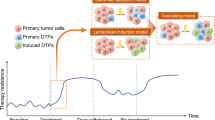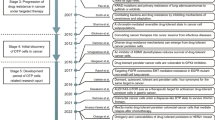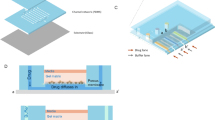Abstract
Developing novel approaches to reverse the drug resistance of tumor-repopulating cells (TRCs) or stem cell-like cancer cells is an urgent clinical need to improve outcomes of cancer patients. Here we show an innovative approach that reverses drug resistance of TRCs using tumor cell-derived microparticles (T-MPs) containing anti-tumor drugs. TRCs, by virtue of being more deformable than differentiated cancer cells, preferentially take up T-MPs that release anti-tumor drugs after entering cells, which in turn lead to death of TRCs. The underlying mechanisms include interfering with drug efflux and promoting nuclear entry of the drugs. Our findings demonstrate the importance of tumor cell softness in uptake of T-MPs and effectiveness of a novel approach in reversing drug resistance of TRCs with promising clinical applications.
Similar content being viewed by others
Log in or create a free account to read this content
Gain free access to this article, as well as selected content from this journal and more on nature.com
or
References
Pattabiraman DR, Weinberg RA . Tackling the cancer stem cells — what challenges do they pose? Nat Rev Drug Discov 2014; 13:497–512.
Wang Z, Li Y, Ahmad A, et al. Targeting miRNAs involved in cancer stem cell and EMT regulation: an emerging concept in overcoming drug resistance. Drug Resist Updat 2010; 13:109–118.
Dean M, Fojo T, Bates S . Tumour stem cells and drug resistance. Nat Rev Cancer 2005; 5:275–284.
Vermeulen L, de Sousa e Melo F, Richel DJ, Medema JP . The developing cancer stem-cell model: clinical challenges and opportunities. Lancet Oncol 2012; 13:e83–e89.
Visvader JE, Lindeman GJ . Cancer stem cells in solid tumours: accumulating evidence and unresolved questions. Nat Rev Cancer 2008; 8:755–768.
Fulda S . Regulation of apoptosis pathways in cancer stem cells. Cancer letters 2013; 338:168–173.
Blanpain C, Mohrin M, Sotiropoulou PA, Passegue E . DNA-damage response in tissue-specific and cancer stem cells. Cell Stem Cell 2011; 8:16–29.
Dean M . ABC transporters, drug resistance, and cancer stem cells. J Mammary Gland Biol Neoplasia 2009; 14:3–9.
Roesch A, Fukunaga-Kalabis M, Schmidt EC, et al. A temporarily distinct subpopulation of slow-cycling melanoma cells is required for continuous tumor growth. Cell 2010; 141:583–594.
Sharma SV, Lee DY, Li B, et al. A chromatin-mediated reversible drug-tolerant state in cancer cell subpopulations. Cell 2010; 141:69–80.
Haq R, Yokoyama S, Hawryluk EB, et al. BCL2A1 is a lineage-specific antiapoptotic melanoma oncogene that confers resistance to BRAF inhibition. Proc Natl Acad Sci USA 2013; 110:4321–4326.
Takebe N, Miele L, Harris PJ, et al. Targeting Notch, Hedgehog, and Wnt pathways in cancer stem cells: clinical update. Nat Rev Clin Oncol 2015; 12:445–464.
Pan Q, Li Q, Liu S, et al. Concise review: targeting cancer stem cells using immunologic approaches. Stem Cells 2015; 33:2085–2092.
Prasad S, Gaedicke S, Machein M, et al. Effective eradication of glioblastoma stem cells by local application of an AC133/CD133-specific T-cell-engaging antibody and CD8 T cells. Cancer Res 2015; 75:2166–2176.
Clevers H . The cancer stem cell: premises, promises and challenges. Nat Med 2011; 17:313–319.
Liu J, Tan Y, Zhang H, et al. Soft fibrin gels promote selection and growth of tumorigenic cells. Nat Mater 2012; 11:734–741.
Tan Y, Tajik A, Chen J, et al. Matrix softness regulates plasticity of tumour-repopulating cells via H3K9 demethylation and Sox2 expression. Nat Commun 2014; 5:4619.
Wolf P . The nature and significance of platelet products in human plasma. Br J Haematol 1967; 13:269–288.
Mause SF, Weber C . Microparticles: protagonists of a novel communication network for intercellular information exchange. Circ Res 2010; 107:1047–1057.
Zhang Y, Zhang R, Zhang H, et al. Microparticles released by Listeria monocytogenes-infected macrophages are required for dendritic cell-elicited protective immunity. Cell Mol Immunol 2012; 9:489–496.
Tang K, Zhang Y, Zhang H, et al. Delivery of chemotherapeutic drugs in tumour cell-derived microparticles. Nat Commun 2012; 3:1282.
Polyak K, Weinberg RA . Transitions between epithelial and mesenchymal states: acquisition of malignant and stem cell traits. Nat Rev Cancer 2009; 9:265–273.
Chen L, Xiao Z, Meng Y, et al. The enhancement of cancer stem cell properties of MCF-7 cells in 3D collagen scaffolds for modeling of cancer and anti-cancer drugs. Biomaterials 2012; 33:1437–1444.
Gottesman MM . Mechanisms of cancer drug resistance. Annu Rev Med 2002; 53:615–627.
Baylin SB . Resistance, epigenetics and the cancer ecosystem. Nat Med 2011; 17:288–289.
Chowdhury F, Na S, Li D, et al. Material properties of the cell dictate stress-induced spreading and differentiation in embryonic stem cells. Nat Mater 2010; 9:82–88.
Holzinger A . Jasplakinolide: an actin-specific reagent that promotes actin polymerization. Methods Mol Biol 2009; 586:71–87.
Beningo KA, Wang YL . Fc-receptor-mediated phagocytosis is regulated by mechanical properties of the target. J Cell Sci 2002; 115:849–856.
Nigg EA, Stearns T . The centrosome cycle: Centriole biogenesis, duplication and inherent asymmetries. Nat Cell Biol 2011; 13:1154–1160.
Salman H, Abu-Arish A, Oliel S, et al. Nuclear localization signal peptides induce molecular delivery along microtubules. Biophys J 2005; 89:2134–2145.
Campbell EM, Hope TJ . Role of the cytoskeleton in nuclear import. Adv Drug Deliv Rev 2003; 55:761–771.
Roberts AJ, Kon T, Knight PJ, Sutoh K, Burgess SA . Functions and mechanics of dynein motor proteins. Nat Rev Mol Cell Biol 2013; 14:713–726.
Bourzac K . Biology: Three known unknowns. Nature 2014; 509:S69–S71.
Valastyan S, Weinberg RA . Tumor metastasis: molecular insights and evolving paradigms. Cell 2011; 147:275–292.
Plodinec M, Loparic M, Monnier CA, et al. The nanomechanical signature of breast cancer. Nat Nanotechnol 2012; 7:757–765.
Cross SE, Jin YS, Rao J, Gimzewski JK . Nanomechanical analysis of cells from cancer patients. Nat Nanotechnol 2007; 2:780–783.
Yamagishi T, Sahni S, Sharp DM, Arvind A, Jansson PJ, Richardson DR . P-glycoprotein mediates drug resistance via a novel mechanism involving lysosomal sequestration. J Biol Chem 2013; 288:31761–31771.
von Schwarzenberg K, Lajtos T, Simon L, Muller R, Vereb G, Vollmar AM . V-ATPase inhibition overcomes trastuzumab resistance in breast cancer. Mol Oncol 2014; 8:9–19.
Zong D, Zielinska-Chomej K, Juntti T, et al. Harnessing the lysosome-dependent antitumor activity of phenothiazines in human small cell lung cancer. Cell Death Dis 2014; 5:e1111.
Sun-Wada GH, Wada Y . Vacuolar-type proton pump ATPases: acidification and pathological relationships. Histol Histopathol 2013; 28:805–815.
Savina A, Jancic C, Hugues S, et al. NOX2 controls phagosomal pH to regulate antigen processing during crosspresentation by dendritic cells. Cell 2006; 126:205–218.
Orr GA, Verdier-Pinard P, McDaid H, Horwitz SB . Mechanisms of Taxol resistance related to microtubules. Oncogene 2003; 22:7280–7295.
Acknowledgements
This work was supported by the National Basic Research Program of China (2014CB542100 and 2012CB932500), the National Science Fund for Distinguished Young Scholars of China (81225021), the National Natural Science Foundation of China (81472653 and 81530080), the Special Fund of Health Public Welfare Profession of China (201302018), and funds from Huazhong University of Science and Technology.
Author information
Authors and Affiliations
Corresponding author
Additional information
( Supplementary information is linked to the online version of the paper on the Cell Research website.)
Supplementary information
Supplementary information, Figure S1
The primary lung tumor cells were drug resistant compared with A549 cell line (Related to Figure 1). (PDF 345 kb)
Supplementary information, Figure S2
Characterization of A549 tumor cell-derived MPs (Related to Figure 1). (PDF 329 kb)
Supplementary information, Figure S3
The size, sterility and drug concentration of A549 derived MPs (Related to Figure 1). (PDF 433 kb)
Supplementary information, Figure S4
The uptake of MPs by immune cells in vitro (Related to Figure 1). (PDF 223 kb)
Supplementary information, Figure S5
Drug-packaging MPs are capable of partially reversing the drug resistance of TRCs (Related to Figure 2). (PDF 432 kb)
Supplementary information, Figure S6
MPs entered the cytoplasm of TRC in an intact form without being packaged into the recipient cellular membrane (Related to Figure 3). (PDF 381 kb)
Supplementary information, Figure S7
MPs facilitate retention of drugs and inhibit drug effluxin TRCs (Related to Figure 4). (PDF 354 kb)
Supplementary information, Figure S8
The relations among the MP membranes, drugs, and lysosomes (Related to Figure 5). (PDF 180 kb)
Supplementary information, Figure S9
MPs facilitate the entry of DOX into the nucleus (Related to Figure 5). (PDF 266 kb)
Supplementary information, Figure S10
Drug-packaging MPs facilitate the entry of DOX into the nucleus (Related to Figure 5). (PDF 161 kb)
Supplementary information, Figure S11
Microtubules butnot centrosome were involved in the MP-mediated entry of drugs into the nucleus of TRCs (Related to Figure 6). (PDF 292 kb)
Supplementary information, Figure S12
The distribution and fate of MPs were detected in mice bearing H22 malignant ascites (Related to Figure 7). (PDF 386 kb)
Supplementary information, Figure S13
(Related to Figure 7). (PDF 292 kb)
Supplementary information, Table S1
Outcomes of clinical treatment (Related to Figure 1). (PDF 272 kb)
Rights and permissions
About this article
Cite this article
Ma, J., Zhang, Y., Tang, K. et al. Reversing drug resistance of soft tumor-repopulating cells by tumor cell-derived chemotherapeutic microparticles. Cell Res 26, 713–727 (2016). https://doi.org/10.1038/cr.2016.53
Received:
Revised:
Accepted:
Published:
Issue date:
DOI: https://doi.org/10.1038/cr.2016.53
Keywords
This article is cited by
-
EphA2-specific microvesicles derived from tumor cells facilitate the targeted delivery of chemotherapeutic drugs for osteosarcoma therapy
Journal of Nanobiotechnology (2024)
-
Extracellular Vesicles for Drug Delivery in Cancer Treatment
Biological Procedures Online (2023)
-
Application of tumor microparticles in tumor prevention and treatment
Cancer Nanotechnology (2023)
-
Apoptotic tumor cell-derived microparticles loading Napabucasin inhibit CSCs and synergistic immune therapy
Journal of Nanobiotechnology (2023)
-
Biophysics in tumor growth and progression: from single mechano-sensitive molecules to mechanomedicine
Oncogene (2023)



